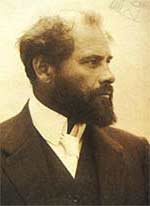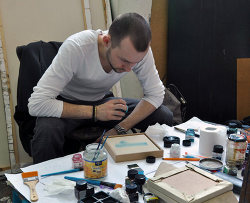
The Hans Sachs Poster Collection for sale by Guernsey’s Auctioneers and Brokers January 18 – 20
In 1891, Henri Toulouse-Latrec produced La Goulue au Moulin Rouge. It soon became the definitive work of the poster revolution. Latrec employed a color palette that was commonly used by 19th Century lithographers yet his work was decidedly more brilliant, his colors more vibrant. When he saw it, Andre Mellerio exclaimed, “This is no longer just a poster, yet it is not a print. It is a work of hybrid pungency deriving the two. It is a modern poster.”
The following year, Latrec produced five other major works of poster art. His production was complimented by artists such as Eugène Grasset, Henri Ibels and Hermann-Paul. The poster revolution was in full swing. Along with their cohorts, these artists filled the streets of Paris with bright color and elegant design. Their posters helped capture the imagination of many young people. And Hans Sachs was one of them.
As the 1890s progressed, the poster revolution spread across the continent. In Germany, a young dental student was smitten by their design. Beginning in that decade Hans Sachs began to collect promotional posters. With a keen eye for design he began to amass one of the finest collections of poster art the world has ever known. After graduation, he had more money to devote to his hobby. He soon published a magazine devoted to Poster collection. The magazine enjoyed a large international following and his collection continued to grow.
In almost every story set in Germany in the early the 20th Century the Nazis come along and ruin things. This is no exception. During a night of gratuitous violence known as Kristalnacht, Hans Sachs was arrested on charges that he was born to Jewish parents. For this offense, he was interned in Sachsenhausen concentration camp and his poster collection was seized by the Gestapo. Sach’s wife was able to post bribe and secure his release. The couple fled to the United States.
Fast forward to 2005. Sachs’ son Peter was a retired airline pilot with a little time on his hands. The lull enabled him to ponder that age old question, “What ever happened to my father’s poster collection?”
As it happens much of it survived the Second World War. Many of Hans Sachs’ posters were stored in the basement of the German Historical Museum in what was once East Berlin. With the help of a team of lawyers with restitution experience, Peter Sachs was ultimately able to regain ownership after a lengthy trip through the German court system.
If the legal battle wasn’t challenging enough, the posters arrived in New York on the night of Hurricane Sandy. A dutiful shipping company was able to get them out of a JFK Airport warehouse as the waters were rising. They were able to get them safely to Guernsey’s Auction House in Manhattan where they will go on sale on January 18th. Those unable to attend the auction may view the catalog and submit bids at Live Auctioneers.
Read More: [Guernsey’s: The Hans Sachs Poster Collection | Live Auctioneers]







